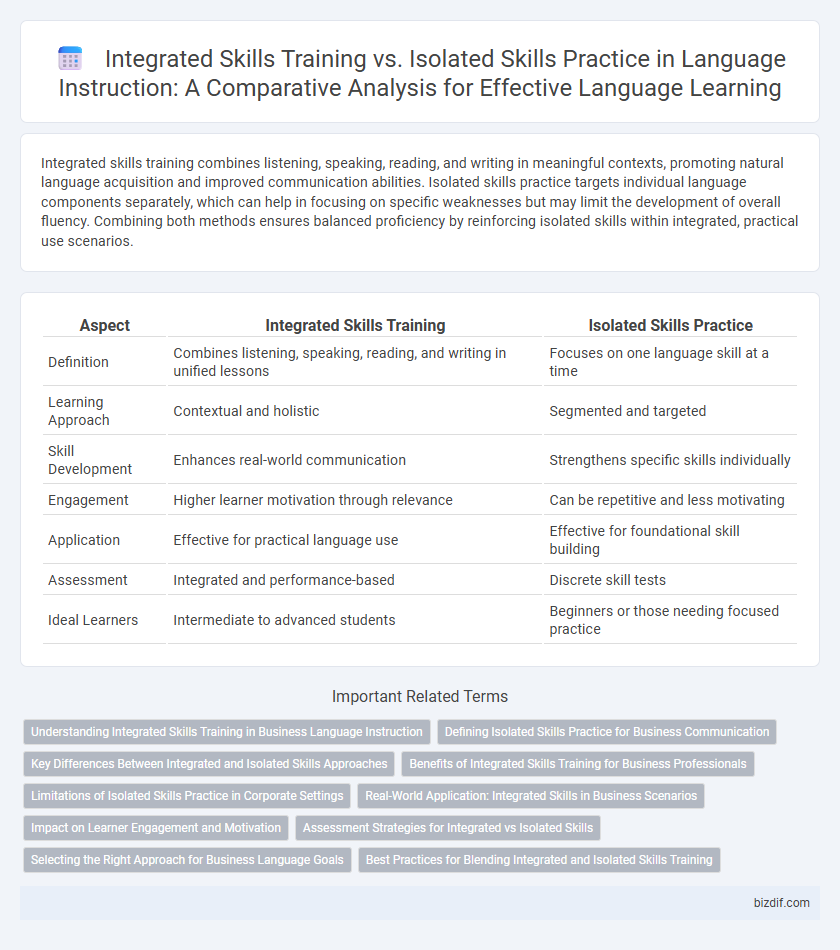Integrated skills training combines listening, speaking, reading, and writing in meaningful contexts, promoting natural language acquisition and improved communication abilities. Isolated skills practice targets individual language components separately, which can help in focusing on specific weaknesses but may limit the development of overall fluency. Combining both methods ensures balanced proficiency by reinforcing isolated skills within integrated, practical use scenarios.
Table of Comparison
| Aspect | Integrated Skills Training | Isolated Skills Practice |
|---|---|---|
| Definition | Combines listening, speaking, reading, and writing in unified lessons | Focuses on one language skill at a time |
| Learning Approach | Contextual and holistic | Segmented and targeted |
| Skill Development | Enhances real-world communication | Strengthens specific skills individually |
| Engagement | Higher learner motivation through relevance | Can be repetitive and less motivating |
| Application | Effective for practical language use | Effective for foundational skill building |
| Assessment | Integrated and performance-based | Discrete skill tests |
| Ideal Learners | Intermediate to advanced students | Beginners or those needing focused practice |
Understanding Integrated Skills Training in Business Language Instruction
Integrated skills training in business language instruction enhances communication proficiency by combining listening, speaking, reading, and writing tasks in real-world contexts. This approach promotes cognitive connections between language skills, fostering practical application and retention. Isolated skills practice, although useful for targeted improvement, often lacks the contextual relevance necessary for effective business communication mastery.
Defining Isolated Skills Practice for Business Communication
Isolated skills practice in business communication focuses on developing individual abilities such as writing emails, delivering presentations, or conducting negotiations separately. This targeted approach allows learners to master specific skills before combining them in real-world scenarios. Emphasizing isolated training helps improve precision and confidence in crucial communication tasks within professional environments.
Key Differences Between Integrated and Isolated Skills Approaches
Integrated skills training combines listening, speaking, reading, and writing within a single instructional framework, promoting real-world communication and contextualized learning. Isolated skills practice targets individual language components separately, allowing focused development and mastery of specific abilities such as vocabulary or pronunciation. The key difference lies in integrated training fostering holistic language use, while isolated practice emphasizes skill-specific accuracy and reinforcement.
Benefits of Integrated Skills Training for Business Professionals
Integrated skills training enhances communication efficiency by simultaneously developing listening, speaking, reading, and writing abilities, essential for dynamic business environments. This method promotes real-world application and context-based learning, increasing retention and practical usability in corporate settings. Business professionals gain improved collaboration and problem-solving skills, directly boosting workplace productivity and interpersonal effectiveness.
Limitations of Isolated Skills Practice in Corporate Settings
Isolated skills practice in corporate language training often fails to reflect real-world communication demands, limiting learners' ability to apply language proficiently in integrated tasks such as meetings or presentations. This approach neglects critical interdependencies between listening, speaking, reading, and writing, reducing overall communicative competence and workplace effectiveness. Consequently, integrated skills training is essential for developing practical language proficiency that aligns with complex corporate interactions and project requirements.
Real-World Application: Integrated Skills in Business Scenarios
Integrated skills training in language instruction enhances real-world application by combining listening, speaking, reading, and writing within authentic business scenarios. This approach mirrors actual workplace communication, fostering practical fluency and enabling learners to navigate complex interactions such as meetings, presentations, and negotiations. Isolated skills practice, while useful for specific competencies, often lacks contextual relevance, limiting learners' ability to transfer skills effectively to dynamic business environments.
Impact on Learner Engagement and Motivation
Integrated skills training enhances learner engagement by combining reading, writing, listening, and speaking activities in cohesive lessons, fostering real-world communication skills and increasing motivation through contextual relevance. Isolated skills practice, while useful for targeted skill development, often leads to reduced motivation due to repetitive, decontextualized tasks that may feel less meaningful to learners. Research shows learners exposed to integrated approaches demonstrate higher intrinsic motivation and sustained engagement compared to those relying solely on isolated practice methods.
Assessment Strategies for Integrated vs Isolated Skills
Assessment strategies for integrated skills training involve evaluating students' ability to simultaneously use listening, speaking, reading, and writing through authentic tasks such as project presentations, group discussions, and multimedia assignments. In contrast, isolated skills practice assessments target specific language components individually, employing objective tests like grammar quizzes, vocabulary matching, or pronunciation drills. Combining formative and summative assessments in integrated skills training offers a holistic measure of communicative competence, while isolated skills assessment provides focused insights into particular linguistic strengths and weaknesses.
Selecting the Right Approach for Business Language Goals
Integrated skills training combines listening, speaking, reading, and writing to simulate real-world business communication, enhancing practical language proficiency efficiently. Isolated skills practice targets specific areas like vocabulary or grammar, ideal for addressing particular weaknesses but less effective for holistic language use. Choosing between these approaches depends on business goals, with integrated training benefiting overall fluency and isolated practice strengthening focused skill gaps.
Best Practices for Blending Integrated and Isolated Skills Training
Blending integrated and isolated skills training maximizes language acquisition by combining focused practice on specific language components with real-world communication scenarios. Effective best practices include using isolated drills to solidify foundational elements like grammar and pronunciation, while employing integrated tasks such as role-plays and discussions to develop fluency and comprehension. Balancing both approaches fosters a comprehensive learning environment that enhances retention, application, and learner confidence.
Integrated skills training vs isolated skills practice Infographic

 bizdif.com
bizdif.com